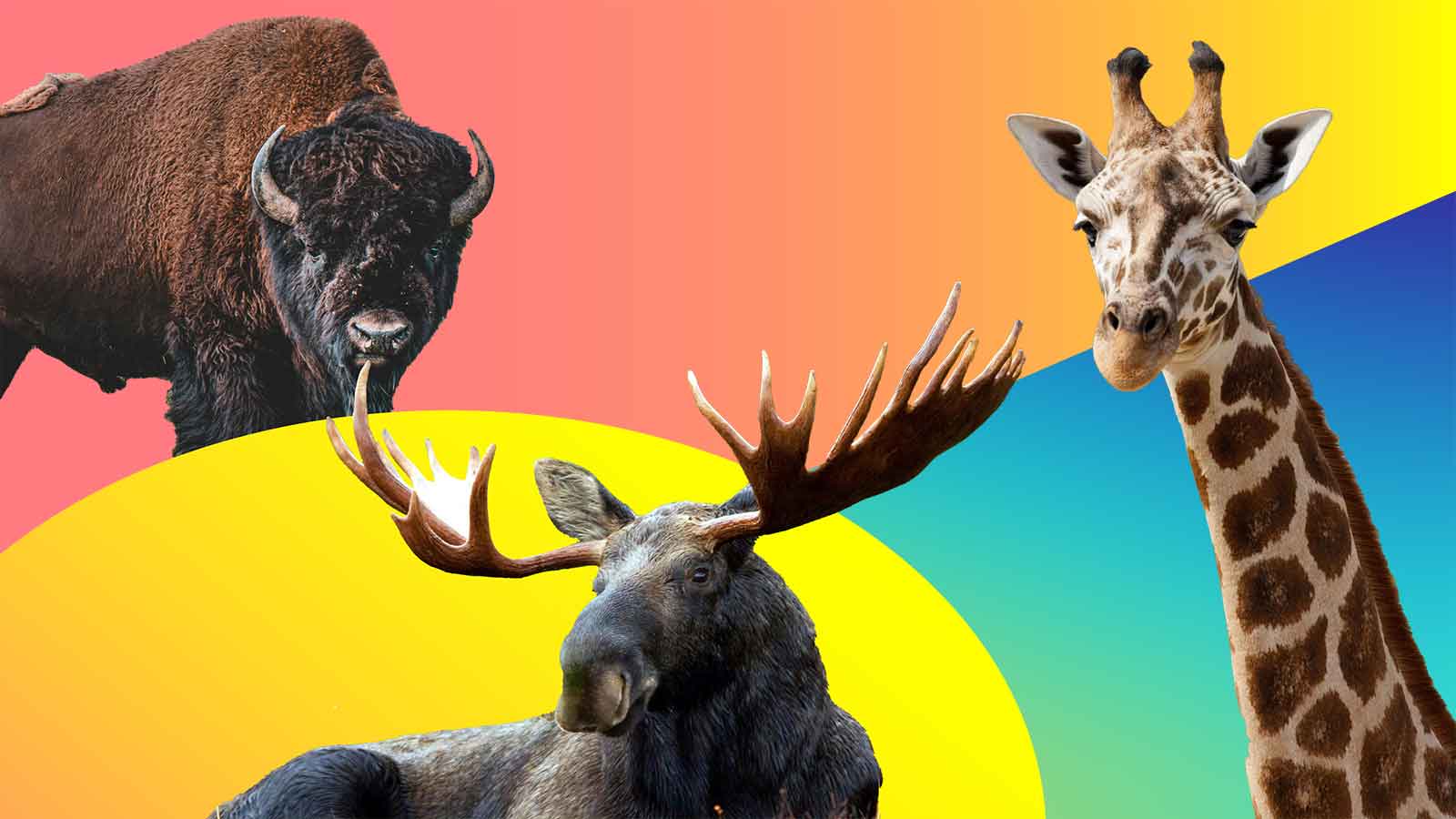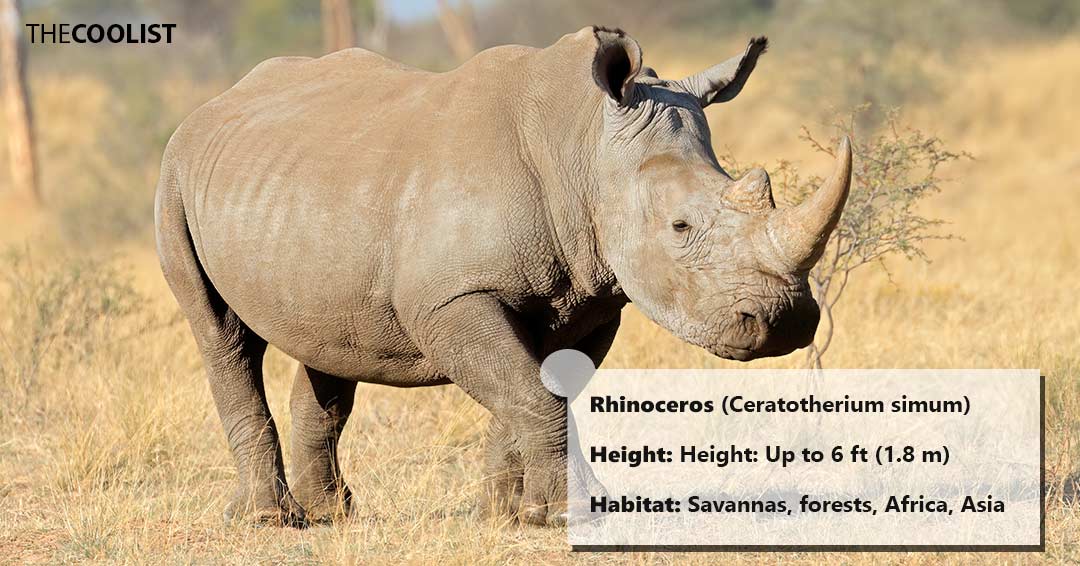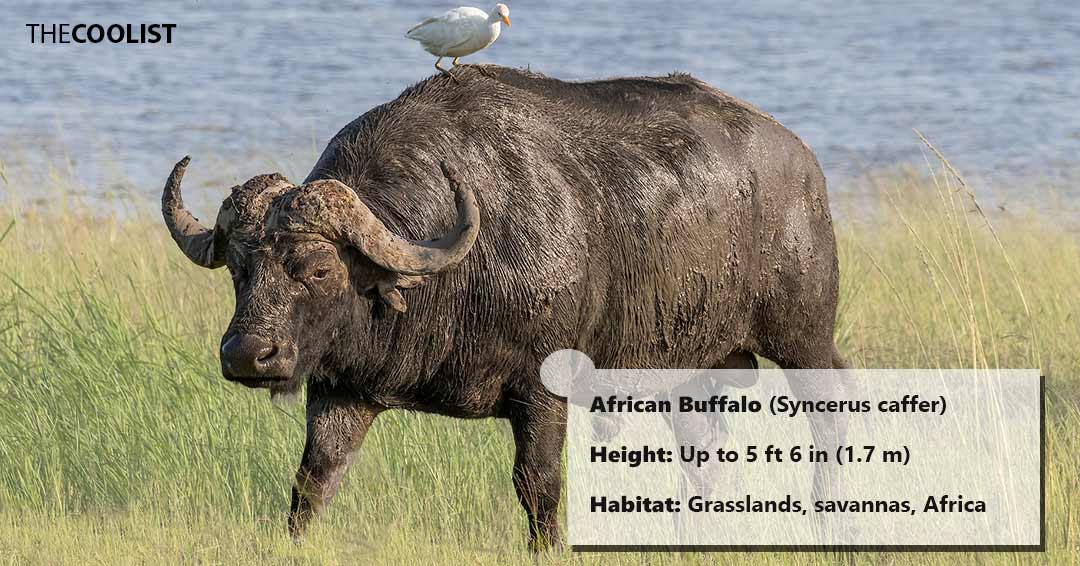The tallest animals in the world reach impressive heights that tower over any adult human. Sizable legs, necks, and body mass contribute to their height, thanks to thousands of years of evolution. These animals use their size to thrive in their habitats, significantly impacting their surroundings.

Today’s tallest living animal in the world is the giraffe, which is native to Africa. It and other giant species exemplify developmental feats that led to successful adaptations and ecological niches. Some of the tallest animals share their height with cousin subspecies, while others dwarf them—creating interest in the ecological effects of size.
We know that these animals are crucial elements of their ecosystems. For instance, most are prey animals that can reach and aid in the seed dispersal of tall trees through their diets. Their bulky size also knocks down growth, creating new terrain that supports food webs or generates crucial pathways for water. However, many are vulnerable to human activities. Some are even endangered. Conservationists seek to recover populations as the elimination of a tall species has irreversible effects on ecosystems and the plants and animals that depend on their gargantuan size.
Below, we discuss these animals in more detail. The list below provides a summary, ranking height in descending order.
- Giraffe: Giraffes are the tallest animal and mammal, growing up to 18 ft (5.5 m). They have long necks and spotted coats, as well as distinct subspecies—all native to Africa.
- Elephant: The African bush elephant is the heaviest and second tallest land animal. They grow up to 13 ft (4 m).
- Polar bear: Polar bears are the largest terrestrial predator, standing up to 10 ft (3m) on hind legs. It is also the largest living bear. They’re found solely in the Arctic Circle, which is shrinking due to climate change.
- Ostrich: The common ostrich is the tallest and heaviest bird, achieving 9.2 ft (2.8 m) in height. They have distinctly long legs and reside in African savannas and deserts.
- Camel: Camels are largely domesticated species native to Middle Eastern and African deserts. The tallest member, the Dromedary camel, grows up to 7.9 ft (2.4 m).
- Moose: The Alaskan moose is the largest living species of deer. They grow up to 7 ft (2.1 m). They additionally sport the largest antlers in the world.
- Horse: Horses are a mostly domesticated species with diverse heights. Shire horses are the largest breed, obtaining 7 ft (2.1 m) with muscular, powerful builds.
- Bison: Bison split into American and European cousins. The latter is slightly taller, reaching heights of 6.9 ft (2.1 m). Both are bulky, sturdy animals that withstand tough terrains.
- Rhino: The white rhino is the tallest living member of the rhinoceros family. It grows to 6 ft (1.8 m), juxtapositioning with smaller cousins.
- African buffalo: The African buffalo is the biggest bovine in Africa, measuring up to 5.6 ft (1.7 m). Its horned head and robust body allow it to survive in mass across the African savannas and forests.
1. Giraffe
The giraffe (Giraffa camelopardalis) achieves heights of up to 18 ft (5.5 m), making it the tallest animal in the world. Each subspecies towers over an adult human. For example, the tallest giraffe subspecies is the Masai giraffe, while the shortest recorded specimen was an Angolan giraffe that stood at 8.5 ft due to dwarfism. Adult giraffes also rank as one of the heaviest animals in the world, averaging 2,600 pounds (1,180 kg).
View in gallery
Giraffes achieve their height thanks to their most distinctive physical features: long necks and legs. Long necks allow them to reach high trees, while strong legs achieve significant speeds at short distances. Giraffes are known for their coats of brown or tan patches. Different subspecies demonstrate different patterns. For instance, reticulated giraffes have solid, large patches whereas Masai giraffe spots are rugged and undefined. Other notable physical features include small humps, long tails and tongues, and horn-like features called ossicones.
These giants inhabit the savannas and grasslands of Sub-Saharan Africa, where they support arboreal food chains, eating from the tallest trees and dispersing seeds. Giraffes are likewise food for predators, namely lions and leopards. Despite this important ecological role, giraffe numbers are vulnerable to poaching and habitat destruction. Positive human interactions center on conservation efforts and ecotourism to preserve the species.
2. Elephant
The elephant is the heaviest and second tallest land animal after the giraffe. African bush elephants (Loxodonta africana) represent the largest species, with some reaching a shoulder height of up to 13 ft (4 m) and a weight of 10.4 tons (about 9,500 kg). Meanwhile, the African forest elephant and the Asian elephant are smaller but still notably large. They respectively grow up to 7 ft 10 in and 9 ft 6 in on average. Male elephants are also larger than females.
View in gallery
These animals have other distinctive features. For example, tusks are present in all species, except female Asian elephants. Large ears, strong trunks, and tough skin provide sensory, foraging, and protective advantages. Additionally, elephants are highly intelligent and social. Female-led herds form close-knit families that rely on the matriarch’s memory and leadership to guide them toward food and water sources.
Elephants inhabit the savannas, forests, and deserts of Africa and Asia. Ecologically, elephants are a keystone species and have a significant effect on their environment. They create water sources, modify landscapes, play crucial roles in seed dispersal, and stave off most predators due to their size. Human interactions, however, threaten elephants, with poachers targeting them for the ivory in their tusks. Conservation initiatives, poaching laws, and zoo programs seek to bolster numbers.
3. Polar bear
Polar bears (Ursus maritimus) are the tallest living bear species. Adult males may grow up to 10 ft (3 m) while standing on their hind legs, and weigh 2,200 lbs (1,000 kg). As a result, polar bears are also the largest living terrestrial predator.
View in gallery
Another prominent physical feature of polar bears is their thick, white fur and layer of fat. Fur acts as camouflage while they hunt seals along shorelines and ice caps. Meanwhile, a 2 to 4-inch (5 to 10 cm) layer of fat insulates them and maintains a vital energy reserve during harsh winters. Their powerful body and large paws additionally make them expert swimmers, utilizing their size to their advantage.
Polar bears inhabit the Arctic where they lead largely solitary lives. Ecologically, the species is an apex predator. However, their numbers are vulnerable due to climate change and melting sea ice. Human interactions today primarily center on conservation and maintaining their habitat.
4. Ostrich
The common ostrich (Struthio camelus) reaches a height of 9.2 ft (2.8 m) as the tallest living species of bird. Ostriches are additionally the heaviest living birds as they can weigh as much as 346 pounds (156.8 kg). A close relative, the Somali ostrich, is the second tallest and heaviest. They achieve a maximum height of 9 ft (2.75 m) and a weight of 290 pounds (130 kg).
View in gallery
Ostriches owe their size to their long necks and powerful legs. The latter allows them to run long distances at speeds of 30 to 37 mph and sprint up to 43 mph. The ostrich body structure is also distinct; they have two toes on each foot, unlike other birds, which aids in running. Meanwhile, their plumage is loose with males primarily having the famous black feathers, while vision is keen and capable of spotting predators at significant distances.
Ostriches are native to the savannas and grasslands of Africa where they help control vegetation and pest populations. Ostriches are not vulnerable; they maintain extensive ranges and diets and adapt well to different environments. Human conservation efforts additionally helped some populations bounce back as these birds are a source of meat, feathers, and leather for local cultures.
5. Camel
Camels are a largely domesticated species capable of heights of 7.9 ft (2.4 m) at the shoulder. These measurements are based on the tallest species of camel, the Dromedary or Arabian camel (Camelus dromedarius). Adults weigh anywhere between 661 to 2,205 pounds (300 to 1,000 kg).
View in gallery
The most distinctive features of camels outside of height are their humps, long necks, and sturdy legs. Humps store fat, which converts into water and energy when resources are scarce. Camels are additionally efficient runners. They have a long gait and flat feet adept at traveling desert stands, allowing them to sustain 25 mph for long distances and 40 mph for sprints. Other notable features include thick eyelashes and sandy fur which protect against desert sand and sun.
Camels predominantly dwell in the deserts and steppes of the Middle East, North Africa, and Asia. They’re primarily domesticated but wild populations exist, ecologically supporting vegetation growth through grazing, seed dispersal, and nutrient cycling. Domestic members have close relationships with humans. They provide transportation, agricultural aid, and companionship, and even act as a source of food and clothing.
6. Moose
The moose (Alces alces) reaches up to 7 ft (2.1 m) at the shoulder and ranks below camels. Moose are the tallest and heaviest living members of the deer family, weighing up to 1,500 pounds (680 kg). The largest representative is the Alaskan moose, dwarfed only by the extinct Cervalces latifrons.
View in gallery
Moose additionally have the largest antlers in the world. These grow to 6 ft (1.8 m) across and weigh over 60 pounds (27 kg). Other notable characteristics include thick fur that protects them from cold climates, a keen sense of smell, and excellent swimming abilities, enabling them to traverse large bodies of water. Their long legs also help them achieve 35 mph (56 km/h) while running.
Moose dwell in North America and Northern European boreal and mixed deciduous forests. Most deer are grazing animals, but moose are selective eaters called bowers. This ecologically impacts forest composition and regeneration, as their browsing influences plant species distribution and growth. They additionally serve as food for predators, such as wolves and bears. Human interactions with moose include hunting, vehicle collisions, and habitat fragmentation, influencing their population and conservation status.
7. Horse
Horses (Equus ferus caballus) are another largely domesticated species capable of many different heights. It ranks at number 7 because one breed, the Shire, grows up to 7 ft (2.1 m) and 2,400 pounds (1,090 kg). Conversely, the Falabella is one of the smallest breeds, averaging only 2 ft to 2.8 ft (0.6 to 0.86 m) and 40 to 100 pounds (18 to 45 kg).
View in gallery
Large horses like the Shore exhibit a muscular build, long necks, and powerful legs. Horses use their size to cross significant distances, pull weights like carriages, and transport individuals. The Shire’s enlarged features especially make it an effective supporter for pulling weight. A pair reportedly pulled 50 tonnes at an exhibition in 1924.
Horses are vital to many elements of human life, so they’re found globally. Feral and wild members live on plains, grasslands, and deserts. They serve critical ecological roles in some habitats through grazing, which helps maintain the health of grasslands. Meanwhile, the height and strength of horses support human living, providing everything from agricultural aid and transportation to companionship and showmanship.
8. Bison
The bison is the tallest member of the bovine family in the Northern Hemisphere and refers to two species: American buffalo (Bison bison) and European bison (Bison bonasus). The latter is typically taller, measuring 6.9 ft (2.1 m) and weighing 1,800 to 2,200 pounds (800 to 1,000 kg). Meanwhile, the American bison reaches a height of 6.6 ft (2 m) but is heavier, growing up to 2,800 pounds (1,270 kg).
View in gallery
Both members display large, humped backs, thick coats, and short, curved horns. Both likewise display impressive feats of strength. Bison travel tough terrains and break through snow and ice to find food. They also use their builds to defend and stave off predators or potential competitors during mating season.
The European bison lives in pockets of European grasslands in wild or controlled habitats. Meanwhile, the American buffalo roams the grasslands and prairies of North America. As grazing animals, they help maintain plant growth, support the nutrient cycle through their manure, and clear underbrush through their mass, preventing overgrowth. However, both populations are vulnerable due to a long history of over-hunting. Human interaction today centers on conservation efforts.
9. Rhinoceros
The rhinoceros ranks at number 9 with white rhinos (Ceratotherium simum) growing to 6 ft (1.8 m) and weighing as much as 4.4 tons (4,000 kg). Consequently, white rhinos are the tallest and heaviest living members of the Rhinocerotidae family. Other members, like the Sumatran or hairy rhino, are smaller and lighter, averaging around 5 ft (1.5 m) in height and 1.5 tons (1,360 kg) in weight.
View in gallery
Rhinoceroses are one of the heaviest terrestrial animals, matched by their height. Thick skin and one or two horns further complement their physique. Rhinos use their size to dominate territory, deter predators, and access high vegetation for feeding. Other features include large, flat feet that distribute their weight and prevent sinking in soft ground as they cross terrains.
Rhinos inhabit various habitats, including savannas, grasslands, and forests in Africa and Asia. They play a significant ecological role. For instance, they graze and create water holes, which benefits other species. However, populations are vulnerable as poachers target most species for their horns due to the ivory trade. Most are endangered. Modern conservation aims to curb these effects.
10. African buffalo
The African buffalo (Syncerus caffer) comes second to the previously discussed bison as it grows to a peak of 5.6 ft (1.7 m). It is the heaviest bovine in Africa, weighing up to 2,000 pounds (900 kg). Cape buffalo represent the largest subspecies whereas Congo buffalo represent the smallest.
View in gallery
These animals additionally exhibit robust builds. They have large horns that grow up to 3.2 ft (1 m) and help them survive the African landscape. Their bodies allow them to travel great distances in search of water and grazing fields, fend off predators, and maintain sizable herds.
Buffalos are quintessential to African savannah, grassland, and forest. They graze large fields, supporting plant growth and the development of water holes. Additionally, African buffalo are a major part of predator diets, namely lions and crocodiles. Human interactions pose a threat to these animals. They’re often the target of hunters—juxtapositioned by the positive attractions of tourists and conservationists who try to maintain their habitat.
What is the importance of the tallest animals for the ecosystem?
The tallest animals all play a vital role in maintaining the ecological balance of their respective ecosystems due to their size. For example, giraffes use their long necks to consume foliage from the tallest trees. This is vital as it curbs overgrowth and aids seed dispersal through the giraffe’s manure. They also function as a prey species, partially sustaining the diets of big cats, hyenas, and wild dogs.
Meanwhile, the polar bear, the largest bear in the world, is an apex predator because of its size, agility, and few competitors. It regulates seal populations, preventing overgrazing of sea ice algae, vital for the Arctic food web. Elephants are keystone species and impact ecosystems due to their size. For instance, they cut down trees and create clearings—leading to grasslands—and break down branches, lowering food for other animals to eat.
What is the tallest animal height recorded?
The tallest animal height ever recorded was a Masai male giraffe that reached 19 ft (5.8 m). The giraffe, named George, lived in Chester Zoo in Upton-by-Chester, Cheshire, England from 1959 to 1969. Most peak heights of Masai giraffes average just a foot under 18 ft. Meanwhile, the tallest extinct animal was the long-necked sauropod dinosaur, Titanosaur, with an estimated shoulder height of 20 feet (6 m) but 46 feet (14 m) tall accounting for the neck. Paleontologists estimate it was the largest terrestrial animal to ever live.
What behaviors are expected of tall animals?
The primary observation of tall animals’ behaviors is that they use their size to their advantage. Each animal’s behavior is distinct due to their ecological role, physical characteristics, and genetics but commonly linked by how size benefits them. For example, giraffes use their long necks and legs to eat from high trees and stand off against predators, respectively. Meanwhile, ostriches achieve significant speeds due to their tall legs, whereas bison leverage their towering stature and bulk for defense.
The same even applies to domestic species. Shire horses’ height enables them to pull heavy loads and perform various farm tasks effectively. Domesticated camels act as pack animals and transport, withstanding travel distance due to their legs and body structure.
Are tall animals aggressive?
Yes, tall animals can be aggressive as many are wild animals with protective instincts. The tallest animal in the world, the giraffe, will swing their necks, kick their long legs, advance, or loudly snort to express agitation. Giraffes are typically non-aggressive and avoid humans but will protect themself if under threat. Other tall animals, such as African bush elephants, should not be approached due to their size and protective instincts. Male members of the species are especially hostile during the breeding season (called the musth period), charging, stomping, or swinging their trunks as signs of aggression.
Are tall animals friendly?
Yes, tall animals can be friendly. Many pose dangers to humans due to their size and territorial or protective instincts. However, horses and many examples of camels are domesticated. This means they’re accustomed to and welcome human handling. They form bonds with each other and with humans, acting as vital labor animals and companions. Meanwhile, elephants are highly social and exhibit affection for their herd mates. Those in captivity interact with humans often, with the animals expressing curiosity and playfulness towards handlers and caretakers.
What are the smallest animals in the world?
Below are three examples of the smallest animals in the world.
- Paedophryne amauensis: Paedophryne amauensis is the world’s smallest frog and vertebrate. It measures just 0.3 inches (7.7 mm) long and inhabits the tropical wetlands of Papua New Guinea. Physical features include granular skin, unwebbed fingers, and brown-black camouflage
- Paedocypris: Paedocypris is the world’s smallest fish genus. The species, Paedocypris progenetica, is its smallest reported member, achieving 0.41 inches (10.3 mm). These fish inhabit the acidic, low-oxygen peat swamp forests of Southeast Asia and have translucent bodies.
- Kitti’s hog-nosed bat: Kitti’s hog-nosed bat is the world’s smallest bat and mammal by length. It measures 1.1 to 1.3 inches (2.8 to 3.3 cm) and resides in the limestone caves of Thailand and Myanmar. With a pig-like snout and compact wings, these bats are insectivores that forage in nearby forests.
